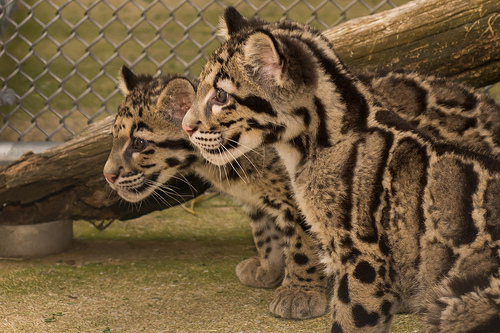Baby Boom at the Smithsonian Conservation Biology Institute
The onset of summer for animal care staff at the Smithsonian Conservation Biology Institute in Front Royal, Va., means patiently awaiting endangered-animal births, hand-raising youngsters and saying farewell to cubs that are ready to be matched with mates. This year, SCBI-Front Royal celebrated its first hatching of the year Jan. 31 with a kiwi chick. Many more species followed, namely clouded leopard cubs, maned wolf pups and a white-naped crane chick. All of these species—which range in International Union for Conservation of Nature Red List status from near threatened to endangered—are significant and represent great conservation successes.
SCBI geneticists have identified the white-naped crane chick that hatched April 14 as a male. The biological parents of the chick, Alex and Amanda, were unable to breed naturally because Amanda was hand-raised and is partially imprinted (socially bonded) with people. Because white-naped cranes are vulnerable to extinction—and because this pair is genetically valuable—SCBI scientists performed an artificial insemination. They then transferred the egg to the care another crane pair, Brenda and Eddie, who had successfully raised chicks before. The chick is doing well and is almost the same size as an adult.
Two male maned wolf pups born April 14 to 2-year-old female Vitani and 8-year-old male, Paul, received a clean bill of health at their first veterinary exam. They appear to be robust and healthy. Keepers have nicknamed the pups Bold and Shy for their distinctive personalities. Only 85 maned wolves are part of the Association of Zoos and Aquariums' Species Survival Plan, and these pups account for 40 percent of successful maned wolf births in the United States this year. A leader in maned wolf conservation, SCBI has had 74 pups born there since 1975—more than any other institution.
Male clouded leopard cub Mingma and his sister, Kali, were transferred to their new home at the Nashville Zoo June 20. Mingma weighed about 9 pounds, and Kali weighed about 8 pounds at a pre-shipment exam. Born Feb. 6, the cubs will be paired with their future mates. Doing so drastically reduces the risk of aggression between these endangered cats when they reach sexual maturity. Clouded leopard infants have a 47 percent survival rate, which soars to 99 percent if the cats are hand-reared. Listed as vulnerable to extinction in the wild, SCBI has had more than 70 clouded leopards born there over the past 30 years and is a leader in conservation science initiatives to save the species.
Female North Island brown kiwi chick Manawa Ora hatched Jan. 31. Her name means hope in Maori. The IUCN considers the brown kiwi an endangered species due, in part, to predation by dogs, cats and stoats (members of the weasel family). The wild population of the brown kiwi is estimated at roughly 24,000, down from 60,000 in the 1980s. Kiwi in zoos are extremely rare. Only five zoos outside of New Zealand have successfully bred these unique birds, and the population is heavily skewed toward males. Manawa Ora will become a valuable breeder because her genes are not well-represented in the captive population. She will remain at SCBI-Front Royal until she reaches sexual maturity at 2-3 years of age.
The Smithsonian Conservation Biology Institute plays a key role in the Smithsonian's global efforts to understand and conserve species and train future generations of conservationists. Headquartered in Front Royal, Va., SCBI facilitates and promotes research programs based at Front Royal, the National Zoo in Washington, D.C., and at field research stations and training sites worldwide.
Photo caption: Female North Island brown kiwi chick Manawa Ora hatched Jan. 31. Her name means hope in Maori.
Photo credit: Chris Crowe, Smithsonian's National Zoo

